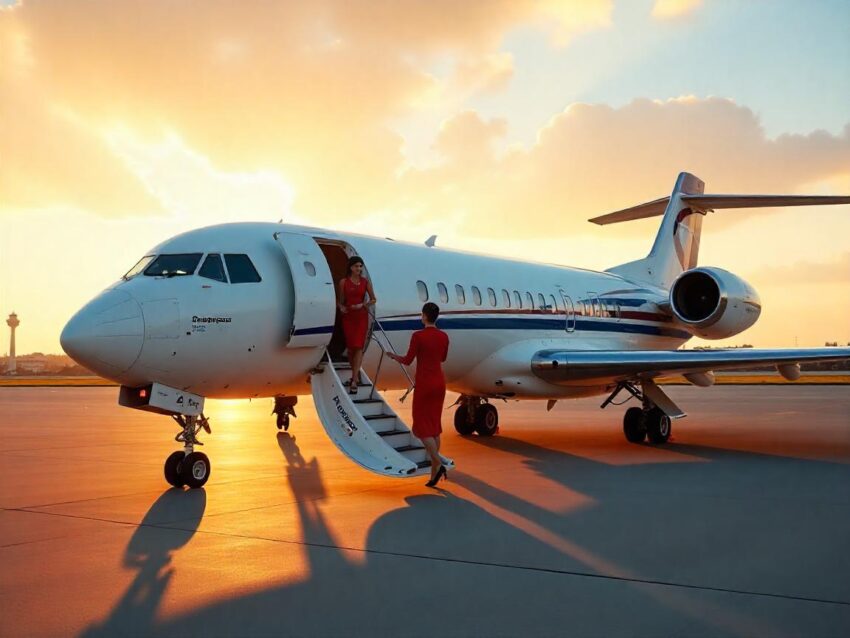Sunday, July 20, 2025

When air travel is associated with delays, cramped seating and service in decline, the name Pan Am takes you to another world. one of silver clippers, globe-trotting glamour and white-gloved service. Now, the iconic brand is returning — though this time, it is coming back to life not as a commercial airline, but a bespoke private jet travel experience. And before long, it’s going to be arriving in Australia.
The Golden Age Recreated In The Air
The stark white Pan Am fuselage and blue globe of a Boeing 757–200 roared out of JFK Airport on June 17, 2025, the beginning of a 12-day inaugural tour christened “Tracing the Transatlantic.” Including just 50 guests on board, the plane stopped in Bermuda, the Azores, Lisbon, Marseille, London and Ireland’s Foynes, retracing Pan Am’s early mid-century routes.
Inside, guests got fully reclining lie-flat beds, fine dining, top-shelf spirits and an on-demand open bar — all done up in the 1960s aesthetic. The Destination The flight attendants sported true-to-the-era Pan Am uniforms, setting a perfect retro mood. But this was no economy trip. Costing almost $60,000 US dollars—or around 90,000 Australian dollars—a ticket, it’s hard for this trip not to be considered at the ultra-luxury end of the travel scale.
An Experience, Not A Flight
For passengers, the experience was far more than a merely more stylish (or spacious or on-time) way to get from point A to point B — in effect, a flying museum and luxury cruise rolled into one. Travelers called it “time travel at 35,000 feet,” where the retro room color palettes to the personalized service all felt like a throwback to the golden age of aviation.
This new Pan Am is not for the hoi polloi. Made for the well-heeled adventurers, aviation enthusiasts, and nostalgic romantics among us —the ones who see travel not as transportation but as a curated journey.
Australia: The Third Visit In The Revival
Australia, of course, which was a huge part of Pan Am’s history, but will soon be back on the map. A 21-day Pacific Tour is set to depart in April 2026 from San Francisco and is tentatively scheduled to visit ports in Asia, Australia, New Zealand and the South Pacific. They are yet to announce their final Australian destination but cities like Sydney, Melbourne or Brisbane are nearest on the radar.
Australian tourism operators and government agencies have reacted with interest in response to the announcement. With Pan Am’s original roots in the region, in the era of flying boats and early transpacific routes, the return of its brand holds cultural significance, as well as potential economic rewards.
Private Jet Tourism Takes Off
Pan Am itself is also part of a broader global trend: ultra-luxury, private jet tourism. Companies such as Four Seasons, Aman and TCS World Travel have all dipped their toes into this market, getting premium travelers to purchase custom black box–style air experiences centered on high service and storytelling.
The key to Pan Am is its heritage. It’s not just another luxury jet service — it’s a resurrection of a storied name that helped define the jet age. A mix of aviation history and modern luxury, they also hold great appeal for those travelers who want more than comfort — who want a sense of the romance of flight.
Behind The Curtain: A Savvy Business Tack
The new Pan Am isn’t functioning as a traditional airline. Rather, it is a brand licensing concern owned by Pan Am Global Holdings. The planes are flown by established carriers like Icelandair on charter contracts. This enables the brand to provide uniform experiences without incurring the crippling costs of operating an entire airline.
It’s a win-win, low-risk, high-reward model that plays on brand nostalgia and makes use of existing aviation infrastructure. No commercial flights, no baggage fees — just meticulously planned, bespoke journeys.
Regulatory Oversight In Australia
For all the grandiosity, each flight still has to adhere to the strictures of the aviation industry. The planes work under FAA charter regulations in the US. Australia: In Australia, all flight operations are subject to Civil Aviation Safety Regulations (CASR), especially Part 91 applicable to private flight.
Pan Am is not listed among CASA holders of an Air Operator Certificate as of mid-2025. This means that the Pacific in 2019 will probably be one of temporary permits or local affiliations with certified Australian operators — a commonly practiced procedure for visiting charters.
Rekindling Aviation Heritage
Pan Am was more than an airport an airline — it was a symbol of American know-how and globalism. It broke ground in transocean routes, brought jet service to the masses and set the bar for cabin service and branding.
Decades after its demise, in 1991, the brand still captivates. The visual representation of the Vietnam War has been preserved by museums, documentaries and references in popular culture. The current revival draws on that emotional inheritance, and on the possibility for neighbors and those farther afield who can afford tickets to experience the glamour that was the province of a privileged few.
What This Means For Australian Tourism
If the tour in April 2026 goes ahead as scheduled, Australian cities can hope to welcome a wave of big spending tourists spending on tailored, premium travel. The boutiques the historical, and the luxury experiebce providers will want Pan Am to be there special partner that moves in coming inbound tourism to a higher and rarer plane.
Final Descent: A Brand Reborn
It’s not the return of Pan Am as a corporate behemoth of the sky. Instead, it’s coming down gently in a niche — luxury, private, nostalgia-driven air travel. For those willing to pony up the premium, it delivers something that’s gotten scarce in today’s aviation world: grace, space, and storytelling.
And soon, when you’re flying it in Australian skies, a new chapter in the history of Pan Am will be written—this time in gold leaf and first-class memories.